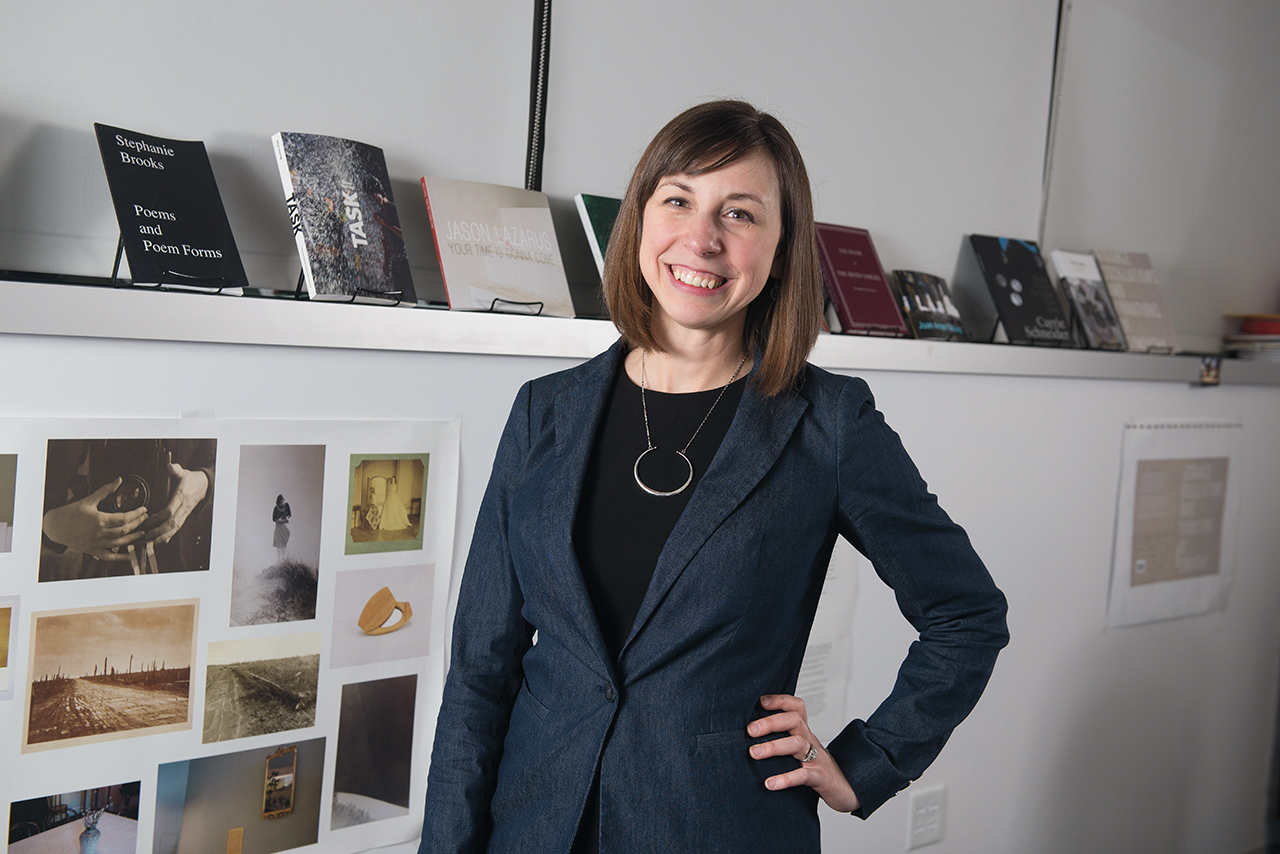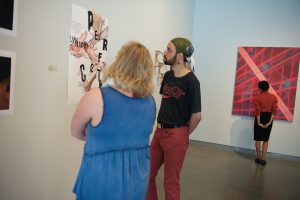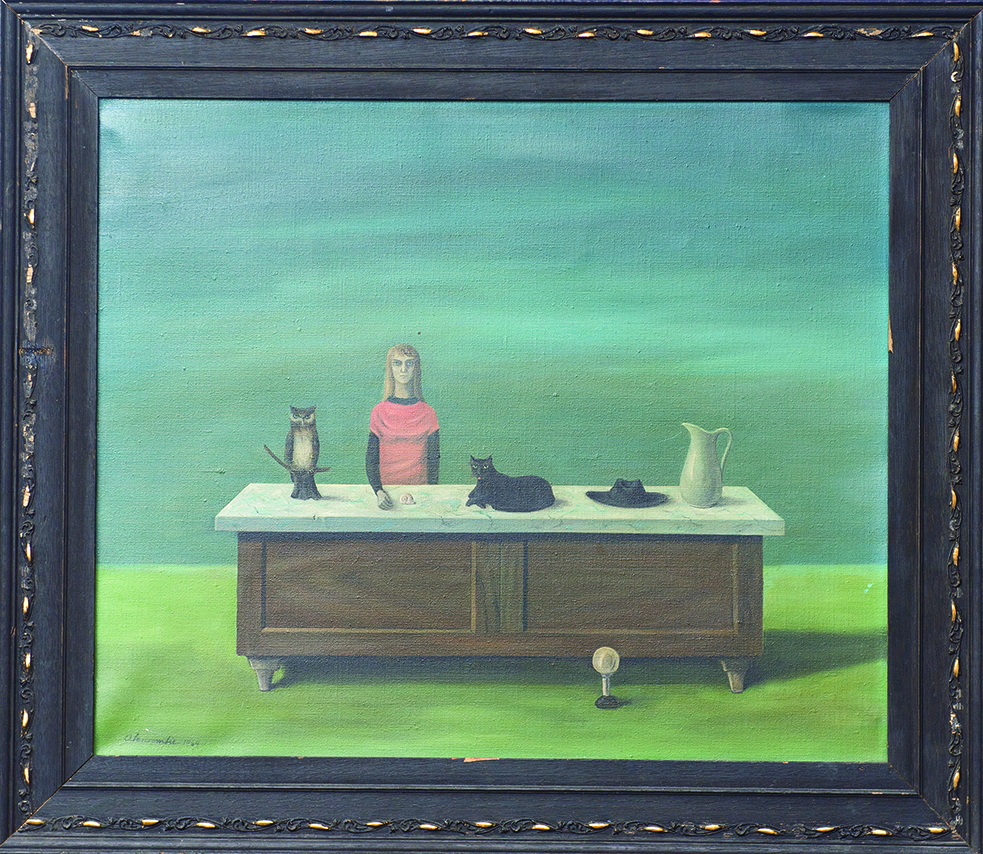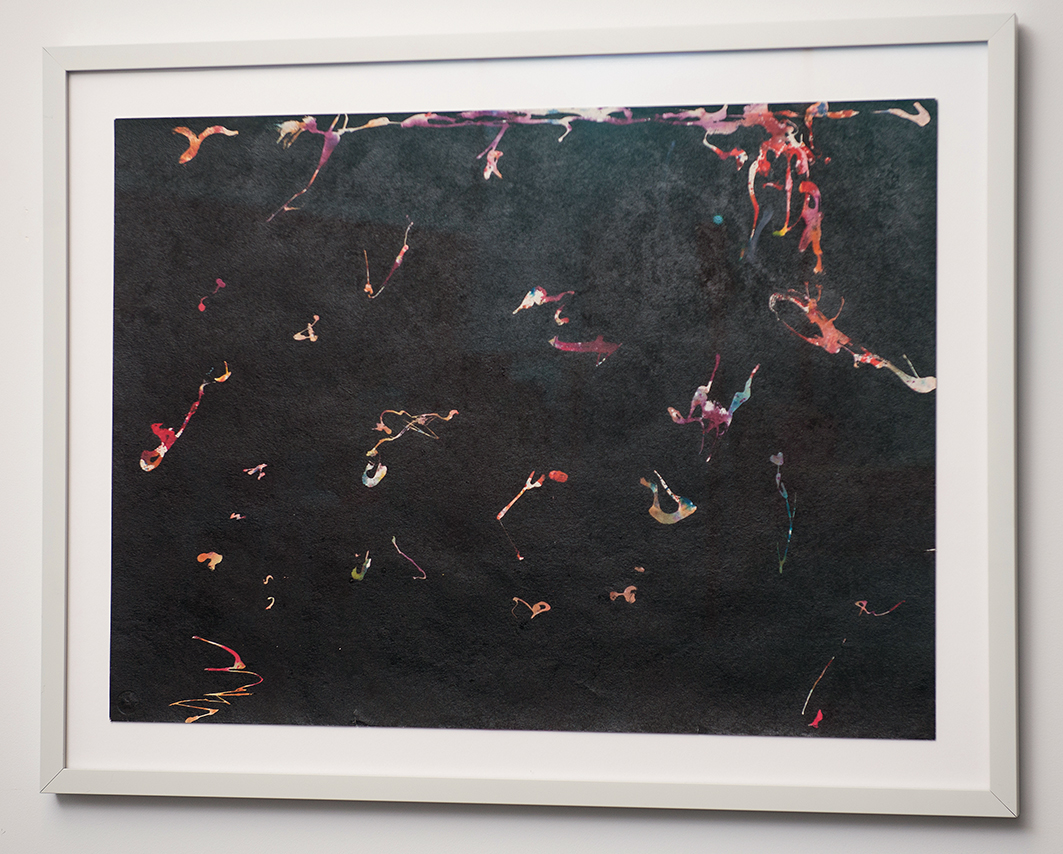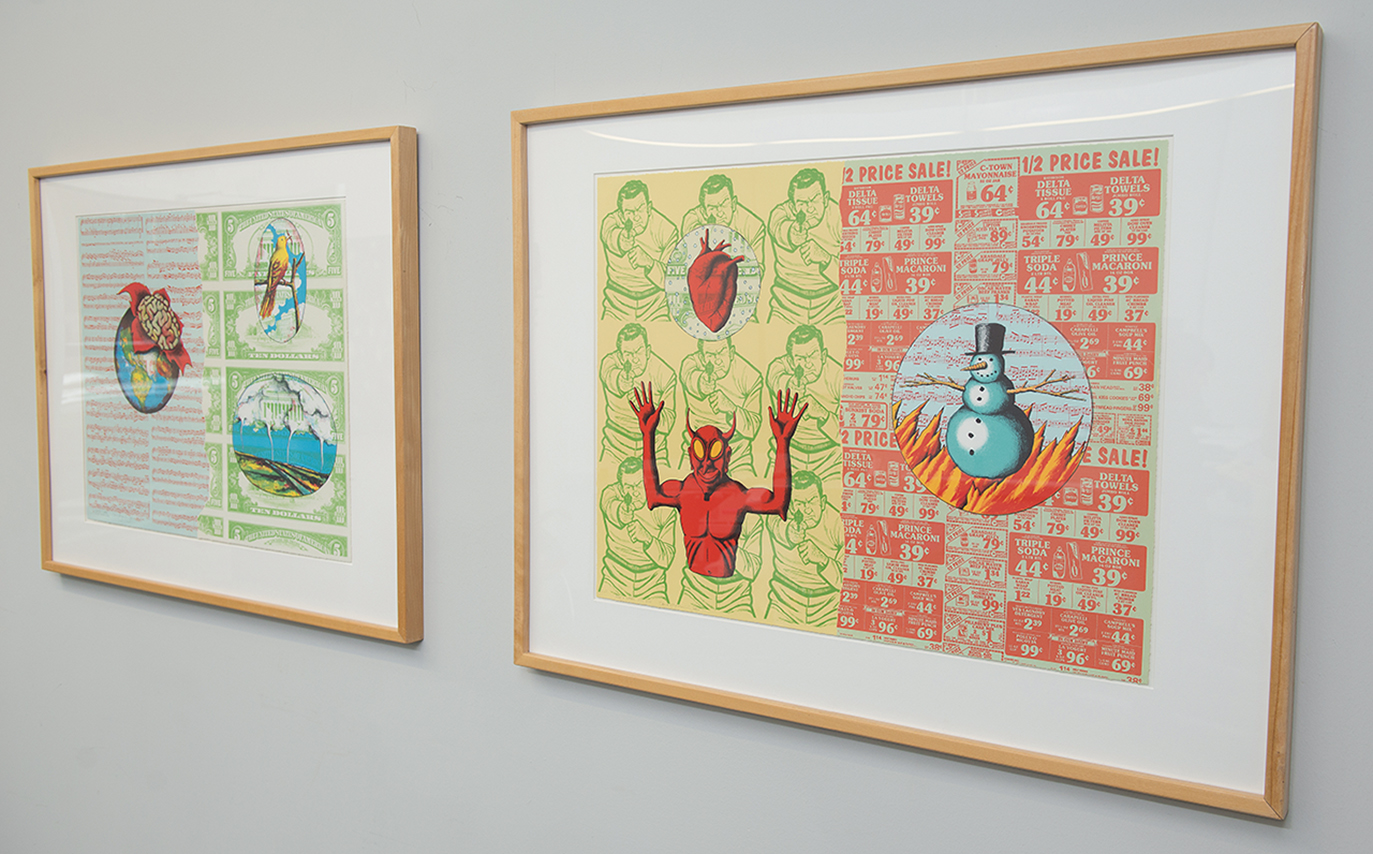Last year, Kendra Paitz, MBA ’06, M.A. ’11, became University Galleries’ first new director since 1987. The longtime curator took over for Barry Blinderman, who retired in June 2018. Blinderman, a charismatic and much-beloved figure, helped drive Illinois State’s premier art space to national prominence due to his reputation as a New York City gallery director and writer and his ability to organize high-profile exhibitions like the first survey of controversial artist David Wojnarowicz’s work.
Paitz worked closely with Blinderman, first as a student and more recently as senior curator, organizing exhibitions, securing grants, and writing about the artists who exhibit at University Galleries. In 2014 she helped Blinderman orchestrate the gallery’s move to a new space in Uptown Normal.
Redbird Scholar sat down with Paitz last February to talk about her career and research at University Galleries and how it has become a valued institution in Bloomington-Normal. The interview has been edited for brevity and clarity.
Appears InHow did you end up here at ISU and with University Galleries?
My undergraduate degree is in studio art. I was fine as an artist, but when I finished in 2002, I couldn’t find a job that I could live off of in Chicago. My best friend was just finishing AmeriCorps and came here for her master’s degree. I said, “I’ll go to Bloomington with you for a month or two while I try to figure things out.” I learned about a program that was here at the time, which is not active anymore. It was an MBA in arts administration. I thought, “That will give me more flexibility.”
At the time, I wanted to open a commercial gallery, and the graduate students in that program primarily helped run the Illinois Shakespeare Festival. I had a phone interview with the director at the time, and he said, “You know, we’d love to have you here with us, but if you’re interested in visual art, you should contact Barry Blinderman at University Galleries and see if he needs a grad assistant.” So I did, and we had a wide-ranging interview. I remember it being two hours, and at the end of it he said, “I want you to be my grad assistant, and you can have the position for the next few years.”
So, I came to ISU and completed the MBA and I was the grad assistant at University Galleries for around three years. Over that time, I started an education program through which I took works from the Permanent Collection into regional schools, and I helped Barry and then senior curator Bill Conger with their exhibitions. I realized that I didn’t want to run a commercial gallery; I wanted to be a curator in an institution of higher education.
Toward the end of my grad assistantship, I asked if I could curate an exhibition. It was a small group show and it got very nice feedback from the faculty and the students. I felt like, “Oh, I can do this.” I loved it and I stayed here. I was then one of the first students enrolled in the visual culture program through the School of Art and received another master’s degree.
How does the role of a university gallery differ from that of a commercial gallery?
There are a lot of commercial galleries that are doing incredible projects and that really support their artists. But, commercial galleries are for-profit. A university gallery is a special place, this one in particular, because of the partnership between the Town of Normal and Illinois State. In the four years we’ve been in this space in Uptown Normal, we’ve really served as a bridge. A university gallery is a place where one can experiment with ideas. It’s an amazing lab for students, not just to come and see work. I’m giving a tour later today for one of (Associate Professor) Duriel Harris’ creative writing classes. We’ll talk about artist Bethany Collins’ work, they’ll see the work, and then they will have an assignment based off their experience of the work. That happens all the time for classes from a variety of departments around the University.
I love serving as a resource in that way, but I’m also passionate about the kinds of professional development opportunities that we can offer students who work at the galleries, where they can help an artist realize an installation,
or they can develop and teach a workshop, or they can design an exhibition catalog. Sometimes they develop lasting relationships with an artist, and the artist becomes a great professional contact for them.
How do you feel about following in Barry’s footsteps?
I’m incredibly grateful for the time that I had at University Galleries as a graduate student, as a curator, a curator of exhibitions, and a senior curator before this. I think that Barry did extraordinary things here for artists, for students, and for staff. He gave me a lot of opportunities and he gave me a lot of autonomy.
When I was being interviewed to become the director and chief curator, one of the things I said to the search committee was that other than the person who is leaving this position after 30 years, I would argue that there’s nobody else as invested in the institutional history of this place and in its future. I take the history of University Galleries and what it’s provided to people through the previous staff members’ efforts very seriously.
It’s also been exciting to be in the process of building a new staff and to be strategizing about how we can keep doing what we’re great at but serve as an even stronger resource for the community and for the University. And we are also thinking about how we can share the stories of what our students are doing, what the artists are doing, what our staff is doing more broadly, whether it’s through social media, publications, conversations, or advocacy.
How do you develop the shows that appear at the galleries? Are these mostly one-time exhibitions or are they part of traveling exhibitions?
It’s a combination; our exhibitions are often one-time, but some travel to other institutions. I’ve put together some exhibitions on fairly short notice, sometimes with a shoestring budget. Sometimes, as with Strange Oscillations and Vibrations of Sympathy (2016), I had the idea three years before the show actually happened. That was a big group show of women artists addressing women writers. Because there were so many artists and so much programming, it required a lot of funding. Once some grants were secured, I started inviting the core artists who I knew had to be a part of this show.
Then I started diving even more fully into the research to expand the project and make sure that we didn’t have two artists hitting the same notes, thinking about the variety of writers they were addressing, and the different practices the artists were engaging in. There were text-based works, newly commissioned site-responsive installations, videos, paintings, photographs, sculptures, and an artist-designed takeaway poster. That represents the longest amount of time I’ve spent on a project.
It was around four years from the initial idea by the time the catalog came out. Many other things were happening
simultaneously while I was working on that exhibition and its catalog: I was working on other books, other exhibitions, other grants, serving on search committees, and working with students.
How do you know what artists or work will fit well with the gallery?
We are committed to showing a wide variety of practices, of voices, with an emphasis on sharing underrepresented viewpoints. The artists that I gravitate toward are using materials in surprising ways, but they’re also artists who are thinking deeply and whose work keeps revealing itself over time through multiple engagements—through thinking about it more, looking at it more, reading more around the periphery of their subject matter. Sometimes I notice a recurring theme in what our students are interested in and will invite an artist here based on that.
We’re also a place where people can come and talk about issues related to social justice, to LGBTQ rights, or how racism is embedded within different structures of language as in Bethany Collins’ exhibition that’s on view right now.
Nationally we are known for giving emerging or midcareer artists their first large-scale survey and their first monograph. These are artists who have an exciting and rich body of work that’s never been brought together in a comprehensive manner. One of my favorite things is organizing a large exhibition for an artist, and if they weren’t here with us installing it, seeing them arrive in time for the opening and hearing their reactions to the show. One artist said, “It’s just like walking around in my brain.” People don’t realize that artists don’t live with all their own work and their studio isn’t necessarily filled with their work. I love when we are able to support artists in that way to draw these different threads together.
Have you had any exhibits that you can remember that have elicited a strong or surprising reaction from the community?
One that was really exciting for me was one of the first group exhibitions that I organized. It was based on themes in Nathaniel Hawthorne’s The House of the Seven Gables. Sometimes literature feels more accessible to a wider audience than contemporary art does. This interpretation of a historical American novel, with themes relating to haunting and ancestral guilt, seemed to resonate with a lot of people. It was especially thrilling to see how many people participated in the programming, including artist talks, reading groups, satellite exhibitions, field trips, and performances.
What is the research you do and how is it published?
Well, the books are truly labors of love. Barry started the publication program when he came here in the late ’80s. The gallery had done important shows before, but this really put this gallery on the map as a place where challenging, exciting, and innovative things were happening, and as a place that supports artists. We had to make books to get the word out, especially at that time. Now, we’re also promoting the exhibitions and programs over social media.
You’ve written and edited 10 books, right?
Ten, yes. I’m in various stages of planning, fundraising, and writing for six more right now, which will be spread over the course of the next few years (if funded). We self-publish them, so most are funded by grants, or sometimes from rental fees for traveling an exhibition.
We typically make the publications after the exhibitions for a few reasons. One is simply time: We’re a small staff. I think our writing is richer because we’ve already given sometimes dozens of tours of that exhibition and because in some cases we’ve been engaging with that particular artist for years by the time we actually exhibit the work and then make the book. Also, making them after the exhibition means we can include documentation of the exhibition itself.
The research consists of a wide variety of reading, looking, and conversing. Whenever possible, I meet with artists in their studios. It’s engaging directly with the artist and hearing their feedback, looking at their processes, sitting with the work with them. It’s living with the work yourself. It’s reading every single thing I can get my hands on related to that artist’s work. Sometimes it means interviewing people that have worked with the artists and making a lot of notes and doing a lot of writing, and a lot of revising. Although there might be a text that’s 2,500 words in the book, at one point it might have been 7,000 or 10,000 words. I’ve become a better writer, certainly, but I think I’ve also become a much better editor of myself and of others. With the support of the grants, we’re able to commission texts by additional writers, so many of our publications offer multiple perspectives on a given artist’s work.
Who is the audience for these catalogs?
The primary audience is people who are interested in that particular artist or medium, whether it’s artists, other curators, museum professionals, faculty, or students
It’s always exciting when we see these books cited in other people’s research. Because they’re often the first books for those artists, they become the definitive source about that artist. So it’s something we take very seriously in nitpicking every little detail, for instance, because it becomes a record up to that point in time for the artist.
Are there any exhibitions that you’d really love to host?
I always have this huge sort of database of artists that I’m thinking about. One of the projects that I’m seeking funding for right now is a large group exhibition that would be about the mysteries and militarization of outer space and linking it also to surveillance culture and climate change.
Also, I’m working with Jen Bervin. She was in Strange Oscillations and Vibrations of Sympathy, and I just wrote an essay for her solo exhibition at the Des Moines Art Center. We are working on funding right now to premiere a project here in the fall of 2020. It’s a five-channel film collaboration that she and her wife will have been working on for four years called Su Hui’s Reversible Poem. It’s about a fourth-century Chinese poet. The story is that the poet wrote and embroidered a 29-by-29 character grid poem to win back her husband from his mistress. According to Jen, it could be read in about 8,000 different ways depending on which direction you follow it. I could go on but those are a few of the projects that are planned or that I’m looking for funding for.
It’s not only professional artists that are exhibiting here, right?
I always say the opening night of the Student Annual is our favorite night of the year. It happens in April every year, and the students’ family members, roommates, and faculty members are here to celebrate their accomplishments. We turn over all of the spaces to showing student work. Any current ISU student is eligible to enter their work for consideration; it’s not just for art students. We bring in external jurors who have not seen the work before to decide which pieces are accepted into the exhibition and which ones get awards. The awards are small scholarships, and several are named in honor of someone. It’s an amazing time to see a snapshot of what our incredibly talented students are thinking about and creating.
Every spring we alternate showing work by all the studio art, arts technology, and art education faculty members and showing the work of our M.F.A. students. Also, last summer we were the inaugural site for the Central Illinois High School Art Exhibition, featuring 150 works by students from nine regional schools. This summer one of the exhibitions will be curated by University Galleries’ inaugural teen arts group; they’ve selected dozens of works from Milner Library’s International Collection of Child Art.
How has the new space in Uptown Normal helped the galleries become a stronger part of the community?
It has been unbelievable: the response, the visibility, the accessibility. We loved our time in the Center for the Visual Arts. That was our home for so long, and we loved that faculty and students could just pop into our offices in between their classes. It turns out that they still do, even though we’re a few blocks away.
Having this new space is a huge honor, to have the Town of Normal and the University believe in University Galleries’ staff and programming enough to enter this partnership and to think that we were the institution that could do this. We’re grateful for our relationships with the town, the University, and the College of Fine Arts. Everything we do is free and open to the public, which is something we’re very proud of and committed to. Whether you’re attending a film screening, an exhibition, an artist lecture, a concert, a workshop, or a symposium, everything is free. We will be doing more off-site workshops, like the one we held with artist William Cordova at the Bloomington Farmers’ Market. We also offer field trip stipends for K–12 schools to offset the costs of bussing. We have a street address so people can use their mapping app to find us and the town has a wide variety of parking options, all of which are free for the first hour. And school buses can drop off right at our front door.
These were huge challenges in our former space. But now we have this increased visibility and accessibility, and we have these huge windows where people can see what’s on view. We think a lot about what we’re putting by those windows in the hopes it will make passersby curious and will make them want to engage. With all the natural light and the volume created by the high ceilings, four years later, people still walk in the front doors and say, “Wow.”
Permanent Collection
There are nearly 3,000 artworks in University Galleries’ Permanent Collection. Artists like Pablo Picasso, Claes Oldenburg, Robert Mapplethorpe, Ansel Adams, and Andy Warhol are represented, as are many of the artists who have exhibited at the gallery. Most of the works are stored in the Center for the Visual Arts or in University Galleries’ Uptown space, but many decorate offices, halls, and gallery walls throughout campus. University Galleries Director and Chief Curator Kendra Paitz highlighted a few of her favorites.
This is a painting from 1964. Gertrude Abercrombie was a Midwestern surrealist. She grew up in Western Illinois and lived in Chicago. She’s famous for having salons with artists and jazz musicians like Sonny Rollins, Charlie Parker, and Dizzy Gillespie. A majority of the paintings function as self-portraits. They have this recurring iconography of shells, owls, and cats, and references to witches and nature. When she passed away, her trust donated her work to various state institutions, and we have three of her paintings.
William Cordova is an internationally recognized artist, and he’s very interested in making work that responds to a site and getting to know members of the community. We were at the Downtown Bloomington Farmers’ Market in August 2018 with concrete mix, inviting members of the public to contribute to it, things they brought from their own backyards or they collected at the market or on their walk that morning. The ingredients all got mixed into the wet concrete and pressed in a mold—the shape of a radio. It became a collective sculpture that was then on view during his exhibition. When the exhibition closed, he wanted it to stay here because it was made by and with the community.
This is a work on paper created by Terry Adkins, M.S. ’77, when he studied printmaking at ISU. Although he is more widely known for his sculptures, installations, and performances, he also made photographs, prints, and videos, and was a jazz musician. I love the elegant and lyrical forms he used here. He would later use abstraction to address complex historical narratives. Terry is one of the most distinguished alumni from our School of Art. I organized the first survey of his videos in 2016. So many people in the College of Fine Arts, School of Art, and University Galleries worked together to endow the School of Art’s Terry Adkins Memorial Scholarship for Diversity, which we were able to announce at the opening of the exhibition.
These are prints made by (the late and famous New York artist) David Wojnarowicz in conjunction with his solo exhibition, Tongues of Flame, that Barry Blinderman organized at University Galleries in the early 1990s. David worked with Illinois State University’s Normal Editions Workshop to make these lithographs. These prints have been influential—the way they bring together different sources like a grocery store flyer, musical score, and currency with imagery relating to the four elements and a critique of American culture. The repeating motif of the man with the gun is actually a shooting range target.
University Galleries
11 Uptown Circle, Suite 103
9:30 a.m.–5 p.m. Monday–Thursday
9:30 a.m.–8 p.m. Friday
Noon–4 p.m. Saturday–Sunday
Galleries.IllinoisState.edu
Facebook.com/UniversityGalleries
Twitter.com/UGalleriesISU
Instagram.com/UniversityGalleriesISU
